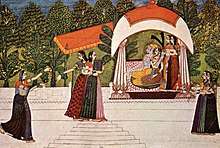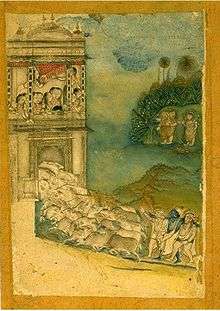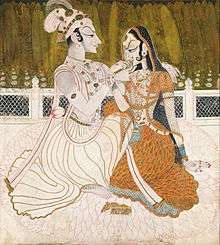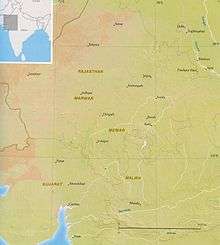Rajput painting
Rajput painting, also called Rajasthani painting, evolved and flourished in the royal courts of Rajputana in northern India, mainly during the 17th and 18th centuries. Artists trained in the tradition of the Mughal miniature were dispersed from the imperial Mughal court, and developed styles also drawing from local traditions of painting, especially those illustrating the Hindu religious epics, the Mahabharata and Ramayana. Each Rajputana kingdom evolved a distinct style, but with certain common features. Miniatures in manuscripts or single sheets to be kept in albums were the preferred medium of Rajput painting, but many paintings were done on the walls of palaces, inner chambers of the forts, havelis, particularly, the havelis of Shekhawati, the forts and palaces built by Shekhawat Rajputs.


Subjects varied, but portraits of the ruling family, often engaged in hunting or their daily activities, were generally popular, as were narrative scenes from the epics or Hindu mythology, as well as some genre scenes of unnamed people.
The colours were extracted from certain minerals, plant sources, conch shells, and were even derived by processing precious stones. Gold and silver were used. The preparation of desired colours was a lengthy process, sometimes taking 2 weeks. Brushes used were very fine.
Content
While there exist a plethora of themes in Rajput paintings, a common motif found throughout Rajput works is the purposeful manipulation of space. In particular, the inclusion of fuller spaces is meant to emphasize the lack of boundaries and inseparability of characters and landscapes. In this way, the individuality of physical characters is almost rejected, allowing both the depicted backgrounds and human figures to be equally expressive.
Outside of a purely artistic standpoint, Rajput paintings were often politically charged and commented on social values of the time. Mewar's rulers wanted these painting to portray their ambitions and establish their legacy. Therefore, paintings were often indicative of a ruler's legacy or their changes made to better society.
Both of these factors clearly distinguish Rajput paintings from Mughal works. While, from a chronological standpoint, both of these cultures clashed with one another, Rajput paintings only superficially adopted Mughal fashion and cultural standards. Elements, such as precise likenesses in portraiture, utilized by popular Mughal artists (Govardhan, Hashim, etc.) are not found in Rajput works. Likewise, Rajput techniques are not predominantly seen in Mughal paintings: "At the opening of the eighteenth century, therefore, Rajput painting remains recognizably different in intent from traditional Mughal attitudes"[1]
Schools

In the late 16th Century, Rajput art schools began to develop distinctive styles, combining indigenous as well as foreign influences such as Persian, Mughal, Chinese and European.[3] Rajasthani painting consists of four principal schools that have within them several artistic styles and substyles that can be traced to the various princely states that patronised these artists. The four principal schools are:
- The Mewar school that contains the Chavand, Nathdwara, Devgarh, Udaipur and Sawar styles of painting
- The Marwar school comprising the Kishangarh, Bikaner style of painting from Bikaner, Jodhpur, Nagaur, Pali and Ghanerao styles
- The Hadoti school with the Kota, Bundi and Jhalawar styles and
- The Dhundar school of Amber, Jaipur, Shekhawati painting and Uniara styles of painting.
The Kangra and Kullu schools of art are also part of Rajput painting. Nainsukh is a famous artist of Pahari painting, working for Rajput princes who then ruled that far north.
Economic prosperity of commercial community and revival of “Vaisnavism” and the growth of Bhakti Cult were the major factors that contributed greatly to the development of Rajasthani paintings. In the beginning this style was greatly influenced by religious followers like Ramanuja, Meerabai, Tulsidas, Sri Chaitanya, Kabir and Ramanand.
All of Rajputana was affected by the attack of the Mughals but Mewar did not come under their control till the last. This was the reason that Rajasthani school flourished first in Mewar, (the purest form and later on in), Jaipur, Jodhpur, Bundi, Kota- Kalam, Kishangarh, Bikaner and other places of Rajasthan.
Notes
- Beach, 175
- "Krishna and Radha". Philadelphia Museum of Art. Retrieved 26 October 2018.
- Neeraj, Jai Singh (1991). Splendour Of Rajasthani Painting. New Delhi: Abhinav Publications. p. 13.
References
- Beach, M, (1992). 1700–1800: The Dominance of Rajput Painting. In Mughal and Rajput Painting (The New Cambridge History of India, pp. 174–213). Cambridge: Cambridge University Press. doi:10.1017/CHOL9780521400275.008
- Kossak, Steven. (1997). Indian court painting, 16th-19th century. Metropolitan Museum of Art. ISBN 0870997831
Further reading
- The City Palace Museum, Udaipur: paintings of Mewar court life. by Andrew Topsfield, Pankaj Shah, Government Museum, Udaipur. Mapin, 1990. ISBN 094414229X.
- Splendour of Rajasthani painting, by Jai Singh Neeraj. Abhinav Publications, 1991. ISBN 81-7017-267-5.
- Art and artists of Rajasthan: a study on the art & artists of Mewar with reference to western Indian school of painting, by Radhakrishna Vashistha. Abhinav Publications, 1995. ISBN 81-7017-284-5.
- A study of Bundi school of painting, by Jiwan Sodhi. Abhinav Publications, 1999. ISBN 81-7017-347-7
- Court painting at Udaipur: art under the patronage of the Maharanas of Mewar, by Andrew Topsfield, Museum Rietberg. Artibus Asiae Publishers, 2001. ISBN 3-907077-03-2.
- Rajput Painting, by Ananda K. Coomaraswamy, Publisher B. R. Publishing Corporation, 2003. ISBN 81-7646-376-0.
- The artists of Nathadwara: the practice of painting in Rajasthan, by Tryna Lyons. Indiana University Press, 2004. ISBN 0-253-34417-4.
- Ghosh, P. (2012). The Intelligence of Tradition in Rajput Court Painting. Art Bulletin, 94(4), 650–652.
- Dalrymple, William, (2016). The beautiful, magical world of Rajput art.] New York Review of Books, November 26, 2016.
External links
| Wikimedia Commons has media related to Rajasthan style. |
